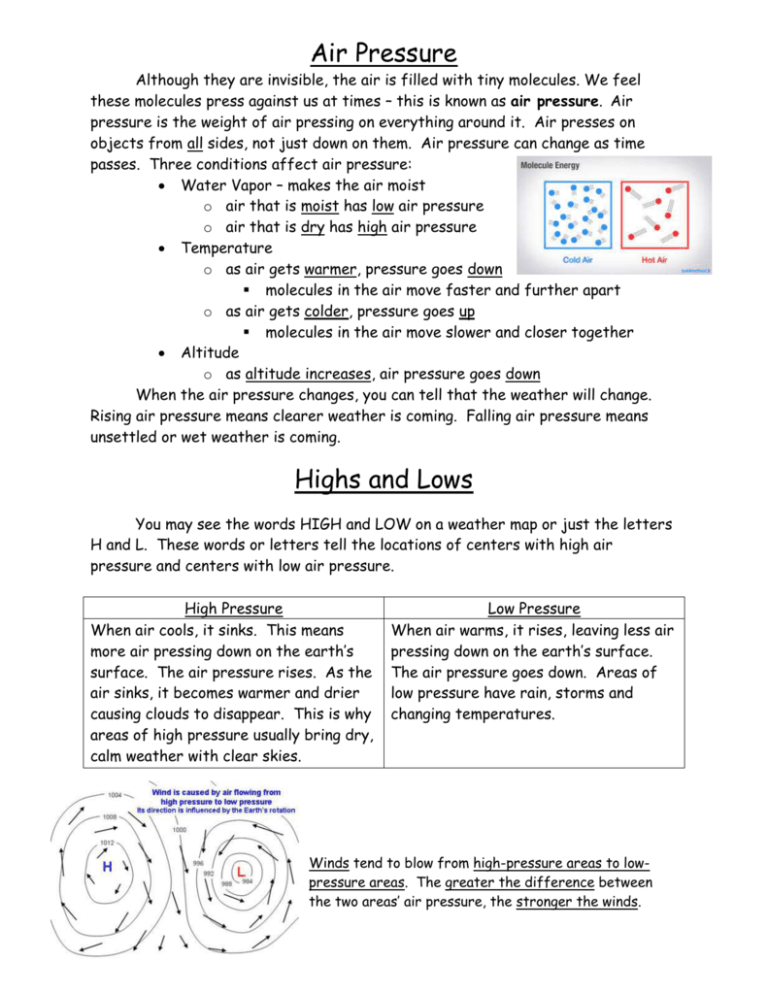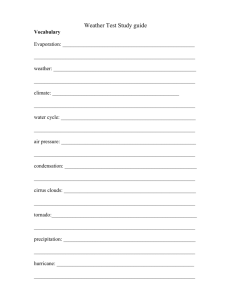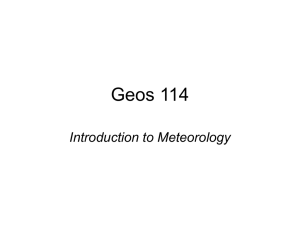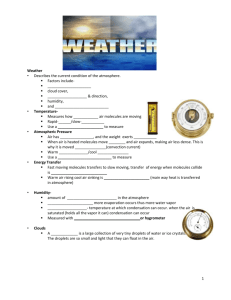Air Pressure
advertisement

Air Pressure Although they are invisible, the air is filled with tiny molecules. We feel these molecules press against us at times – this is known as air pressure. Air pressure is the weight of air pressing on everything around it. Air presses on objects from all sides, not just down on them. Air pressure can change as time passes. Three conditions affect air pressure: Water Vapor – makes the air moist o air that is moist has low air pressure o air that is dry has high air pressure Temperature o as air gets warmer, pressure goes down molecules in the air move faster and further apart o as air gets colder, pressure goes up molecules in the air move slower and closer together Altitude o as altitude increases, air pressure goes down When the air pressure changes, you can tell that the weather will change. Rising air pressure means clearer weather is coming. Falling air pressure means unsettled or wet weather is coming. Highs and Lows You may see the words HIGH and LOW on a weather map or just the letters H and L. These words or letters tell the locations of centers with high air pressure and centers with low air pressure. High Pressure When air cools, it sinks. This means more air pressing down on the earth’s surface. The air pressure rises. As the air sinks, it becomes warmer and drier causing clouds to disappear. This is why areas of high pressure usually bring dry, calm weather with clear skies. Low Pressure When air warms, it rises, leaving less air pressing down on the earth’s surface. The air pressure goes down. Areas of low pressure have rain, storms and changing temperatures. Winds tend to blow from high-pressure areas to lowpressure areas. The greater the difference between the two areas’ air pressure, the stronger the winds. Air Masses Air masses are giant “bubbles” of air that move in the atmosphere over the Earth. An air mass has similar temperatures and humidity throughout. These air masses form over different parts of the Earth and can be a combination of warm or cold, and dry or moist. Typically, air masses are classified according to the characteristics of their source region or area of formation. A source region can have one of four temperature attributes: equatorial, tropical, polar or arctic. Air masses are also classified as being either continental (over land) or maritime (over water) in terms of moisture characteristics. Combining these two categories, several possibilities are commonly found associated with North America: maritime polar (mP), continental polar (cP), maritime tropical (mT), continental tropical (cT), and continental arctic (A). 1. What air mass mostly affects NC? 2. What are the characteristics of this air mass? (warm, cold, dry, moist) Weather Fronts Cold air masses are high pressure systems, while warm air masses are low pressure systems. These air masses are in constant battle with one another. As one air mass moves in, another must move on and out or up. When two different types of air masses meet, a front forms. When a front moves over an area, the weather changes. There are four different types of fronts: 1. Cold Front: (blue triangles) Cold air is denser (heavier) and pushes warm air out of its way, like a snow plow moving down the street, forcing the warm air to rise steeply. Cumulus and cumulonimbus clouds form and rain, thunderstorms, hail and tornadoes can occur. 2. Warm Front: (red half-circles) Warm air slides up and over cold air. Cirrus clouds form ahead of the front. As the front comes closer, stratus clouds form at lower levels in the atmosphere. These clouds can change to nimbostratus clouds and produce rain, snow, sleet and freezing rain. 3. Stationary Front: (blue triangles and red half-circles on opposite sides of the front) Neither warm air nor cold air is able to get the upper hand and advance. This causes widespread clouds on both sides of the front. On a weather map, the triangles or semicircles symbolizing the front point in the direction it’s traveling. The line that the triangles or semicircles are attached to show the boundary of the front. Directions: Label the fronts with the correct name and color them appropriately. 1. _________________________ 3. _________________________ 2. __________________________











